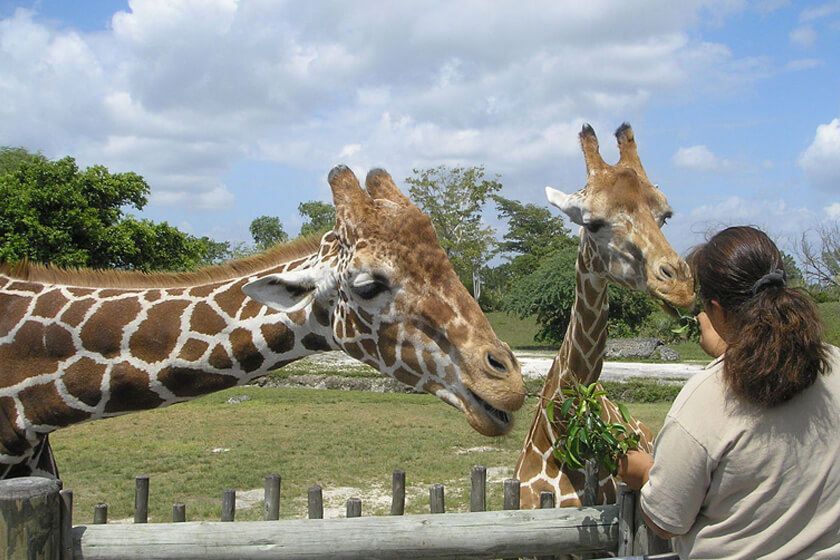West Long Branch, NJ – A majority of Americans feel that circus animals are rarely treated well and support a ban on using wild animals in circuses. The Monmouth University Poll also finds that most, but by no means all, Americans believe that wild animals in aquariums, zoos, safari parks, and marine parks are generally well-treated. However, the public is divided on whether the main role of these exhibits is to focus on education or entertainment.
A majority of Americans (54%) would favor a law to prohibit the use of wild animals in circuses, while 34% would oppose such a law. Politically self-described liberals (72%) are much more likely than conservatives (42%) to support banning wild animal acts, with moderates (56%) falling in the middle. Women (60%) are more supportive of a ban than men (48%), while adults under the age of 35 years old (65%) are more likely to support such a ban than are those aged 35 to 54 (53%) or 55 and older (47%). There is not much difference in support levels for a ban on circus animal acts when the opinions of those who have been to a circus in the past ten years (50%) are compared with those who have not visited a circus (56%).
In general, the public is likely to feel that places which exhibit wild animals are more focused on entertainment rather than education, although the degree to which they hold this opinion varies by the type of facility. The public overwhelmingly believes that circuses are focused primarily on providing the public with an enjoyable experience (81%). Just 5% say the primary aim of circuses is to educate the public about wildlife conservation and 3% say circuses focus on both functions equally.
A majority of the public also believes that marine animal parks with dolphins and whales are more focused on public entertainment (54%) as opposed to education (21%), with 14% saying they do both equally. A plurality sees safari parks as more focused on entertainment (44%) than education (27%), with 16% saying they do both equally. A plurality also sees zoos as more focused on providing the public with an enjoyable experience (43%) compared with educating the public about wildlife conservation (32%), with 19% saying they do both equally.
Public opinion is more divided on aquariums, with 39% saying these facilities are more focused on providing an enjoyable experience and 35% saying they are more focused on educating the public, while 19% say they do both equally. Interestingly, aquariums are the only type of wild animal facility covered in the survey where there are regional differences in the poll results. While most regions of the country are largely in line with national opinion on this question, those who live on the West Coast are actually more likely to say that aquariums are focused mainly on education (43%) rather than entertainment (31%), with 19% saying they focus on both equally.
Nearly three-quarters of the public say that animals in aquariums are generally well-treated (24% all of the time and 49% most of the time), while nearly two-thirds say the same about zoos (18% all of the time and 48% most of the time) and safari parks (18% all of the time and 45% most of the time). Between 2-in-10 and 3-in-10 have a negative view on whether wild animals are well-treated in zoos (26% just some of the time and 3% none of the time), safari parks (23% just some of the time and 3% none of the time), and aquariums (19% just some of the time and 2% none of the time).
A majority of Americans say that animals in marine parks are generally well-treated (16% all of the time and 41% most of the time), while more than 1-in-3 feel that this is usually not the case (29% just some of the time and 8% none of the time).
Only 3-in-10 Americans feel that circus animals are well-treated (7% all of the time and 24% most of the time). Another 6-in-10 are more doubtful that circus animals are well-treated (40% just some of the time and 21% none of the time).
In general, those who have visited these wildlife exhibits in the past ten years are between 11 and 14 percentage points more likely than those who have not visited to feel the animals there are well-treated. The only exception is zoos where the difference in opinion between visitors and non-visitors is just 4 points.
“Recent developments in animal law reflect concerns not only about poor treatment of wildlife in captivity, but with concerns about captivity itself. Litigation that may impact zoos and marine animal parks has focused on concerns about how captivity is unnatural and harmful to the psychological and emotional well-being of some of these animals, regardless of how ‘humane’ the conditions of confinement and treatment of these animals may be,” said Randall Abate, the Rechnitz Family/Urban Coast Institute Endowed Chair in Marine and Environmental Law and Policy and author of “What Can Animal Law Learn from Environmental Law?”
“The fact that public concern for animal welfare is at an all-time high is a positive development as we are faced with critical global threats of species extinctions and reduced biodiversity. But society needs to move away from seeing ‘captivity’ as a necessarily negative construct. Zoological institutions have increased their collaboration with universities to conduct research on training in positive animal husbandry and enrichment in addition to breeding critically endangered species and treating diseases that threaten wildlife. Animal welfare science and education plays a crucial role in providing the best possible life for individual animals as well as wild animal populations,” said Lindsay Mehrkam, assistant professor of psychology, program coordinator for the Six Flags Field Experience Affiliation and principal investigator of the Human-Animal Wellness Collaboratory at Monmouth University.
Most wildlife exhibitors feature animal demonstrations, but there is a question as to what purpose these demonstrations play. For example, the public is divided over the role of feeding time shows at zoos – 35% say these demonstrations are mainly to put on a fun show for the public while 19% say they are mainly to educate the public about the animals, although 42% say they serve both purposes equally. Turning to marine animal parks, most Americans believe that the primary role of dolphin and seal performances in these facilities is to entertain the public (62%). Just 6% say the main purpose of these shows is to educate the public and 30% say these demonstrations are equally about education and entertainment. More than 8-in-10 (82%) say that wild animal acts at circuses are primarily about putting on a fun show, with just 2% saying they are about educating the public and 13% saying they fulfill both roles equally.
“Wildlife exhibitors are in a bind. The success of their conservation mission relies on public support, but that support is driven in part from finding ways for people to connect with these animals through feeding demonstrations and up-close experiences,” said Patrick Murray, director of the independent Monmouth University Polling Institute.
More than 2-in-3 Americans (69%) report visiting a zoo in the past ten years and 6-in-10 have visited an aquarium (59%). They are relatively less likely to have visited marine animal parks (30%), safari parks (25%), and circuses (25%). Seventeen percent of the public say they have not visited any of these places in the past decade. Parents of children under age 18 are between 7 and 17 points more likely than non-parents to report having visited any of these places.
The Monmouth University Poll was conducted by telephone from March 1 to 4, 2019 with 802 adults in the United States. The question results in this release have a margin of error of +/- 3.5 percentage points. The poll was conducted by the Monmouth University Polling Institute in West Long Branch, NJ.
Monmouth University will host a panel discussion on “Animal Welfare: The Higher Education Perspective” on Tuesday, March 26 at 6 p.m. in the University’s Wilson Auditorium. The event is free and open to the public.
QUESTIONS AND RESULTS
(* Some columns may not add to 100% due to rounding.)
[Q1-29 previously released.]
30. Do you think [READ ITEM] are more focused on educating the public about wildlife conservation or more focused on providing the public with an enjoyable experience?
[ITEMS WERE ROTATED]
Zoos
| March 2019 | |
| Educating the public about wildlife conservation | 32% |
| Providing the public with an enjoyable experience | 43% |
| (VOL) Both equally | 19% |
| (VOL) Neither | 1% |
| (VOL) Don’t know | 5% |
| (n) | (802) |
Safari parks where you drive around to see the animals
| March 2019 | |
| Educating the public about wildlife conservation | 27% |
| Providing the public with an enjoyable experience | 44% |
| (VOL) Both equally | 16% |
| (VOL) Neither | 1% |
| (VOL) Don’t know | 12% |
| (n) | (802) |
Aquariums
| March 2019 | |
| Educating the public about wildlife conservation | 35% |
| Providing the public with an enjoyable experience | 39% |
| (VOL) Both equally | 19% |
| (VOL) Neither | 1% |
| (VOL) Don’t know | 6% |
| (n) | (802) |
Marine animal parks with dolphins and whales
| March 2019 | |
| Educating the public about wildlife conservation | 21% |
| Providing the public with an enjoyable experience | 54% |
| (VOL) Both equally | 14% |
| (VOL) Neither | 1% |
| (VOL) Don’t know | 9% |
| (n) | (802) |
Circuses with wild animals
| March 2019 | |
| Educating the public about wildlife conservation | 5% |
| Providing the public with an enjoyable experience | 81% |
| (VOL) Both equally | 3% |
| (VOL) Neither | 4% |
| (VOL) Don’t know | 6% |
| (n) | (802) |
31. Do you think the wild animals in [READ ITEM] are generally well-treated all of the time, most of the time, just some of the time, or none of the time? [ITEMS WERE ROTATED]
Zoos
| March 2019 | |
| All of the time | 18% |
| Most of the time | 48% |
| Just some of the time | 26% |
| None of the time | 3% |
| (VOL) Depends, mixed | 2% |
| (VOL) Don’t know | 4% |
| (n) | (802) |
Safari parks
| March 2019 | |
| All of the time | 18% |
| Most of the time | 45% |
| Just some of the time | 23% |
| None of the time | 3% |
| (VOL) Depends, mixed | 1% |
| (VOL) Don’t know | 10% |
| (n) | (802) |
Aquariums
| March 2019 | |
| All of the time | 24% |
| Most of the time | 49% |
| Just some of the time | 19% |
| None of the time | 2% |
| (VOL) Depends, mixed | 1% |
| (VOL) Don’t know | 5% |
| (n) | (802) |
Marine animal parks
| March 2019 | |
| All of the time | 16% |
| Most of the time | 41% |
| Just some of the time | 29% |
| None of the time | 8% |
| (VOL) Depends, mixed | 1% |
| (VOL) Don’t know | 5% |
| (n) | (802) |
Circuses
| March 2019 | |
| All of the time | 7% |
| Most of the time | 24% |
| Just some of the time | 40% |
| None of the time | 21% |
| (VOL) Depends, mixed | 2% |
| (VOL) Don’t know | 6% |
| (n) | (802) |
[QUESTIONS 32 – 34 WERE ROTATED]
32. Would you say the main purpose of feeding time shows at zoos is more to educate the public about the animals or more to put on a fun show, or both equally?
| March 2019 | |
| Educate about animals | 19% |
| Put on a fun show | 35% |
| Both equally | 42% |
| (VOL) Neither | 1% |
| (VOL) Don’t know | 4% |
| (n) | (802) |
33. Would you say the main purpose of performances by marine animals like dolphins and seals at marine animal parks is more to educate the public about the animals or more to put on a fun show, or both equally?
| March 2019 | |
| Educate about animals | 6% |
| Put on a fun show | 62% |
| Both equally | 30% |
| (VOL) Neither | 0% |
| (VOL) Don’t know | 2% |
| (n) | (802) |
34. Would you say the main purpose of circus acts using wild animals is more to educate the public about the animals or more to put on a fun show, or both equally?
| March 2019 | |
| Educate about animals | 2% |
| Put on a fun show | 82% |
| Both equally | 13% |
| (VOL) Neither | 1% |
| (VOL) Don’t know | 2% |
| (n) | (802) |
35. Would you favor or oppose a law to prohibit the use of wild animals in circuses?
| March 2019 | |
| Favor | 54% |
| Oppose | 34% |
| (VOL) Don’t know | 11% |
| (n) | (802) |
36. In the past ten years, have you visited a zoo, safari park, aquarium, marine animal park, or circus? [If YES: Which ones?] [Note: Results add to more than 100% because multiple responses were accepted]
| March 2019 | |
| Zoo | 69% |
| Safari parks | 25% |
| Aquariums | 59% |
| Marine animal parks | 30% |
| Circus | 25% |
| No, none of these | 17% |
| (VOL) Don’t know | 1% |
| (n) | (802) |
METHODOLOGY
The Monmouth University Poll was sponsored and conducted by the Monmouth University Polling Institute from March 1 to 4, 2019 with a national random sample of 802 adults age 18 and older, in English. This includes 322 contacted by a live interviewer on a landline telephone and 480 contacted by a live interviewer on a cell phone. Telephone numbers were selected through random digit dialing and landline respondents were selected with a modified Troldahl-Carter youngest adult household screen. Monmouth is responsible for all aspects of the survey design, data weighting and analysis. Final sample is weighted for region, age, education, gender and race based on US Census information. Data collection support provided by Braun Research (field) and SSI (RDD sample). For results based on this sample, one can say with 95% confidence that the error attributable to sampling has a maximum margin of plus or minus 3.5 percentage points (unadjusted for sample design). Sampling error can be larger for sub-groups (see table below). In addition to sampling error, one should bear in mind that question wording and practical difficulties in conducting surveys can introduce error or bias into the findings of opinion polls.
| DEMOGRAPHICS (weighted) |
|
Self-Reported |
| 26% Republican |
| 43% Independent |
| 31% Democrat |
| 48% Male |
| 52% Female |
| 30% 18-34 |
| 34% 35-54 |
| 36% 55+ |
| 63% White |
| 13% Black |
| 16% Hispanic |
|
9% Asian/Other |
| 69% No degree |
| 31% 4 year degree |
Click on pdf file link below for full methodology and crosstabs by key demographic groups.




